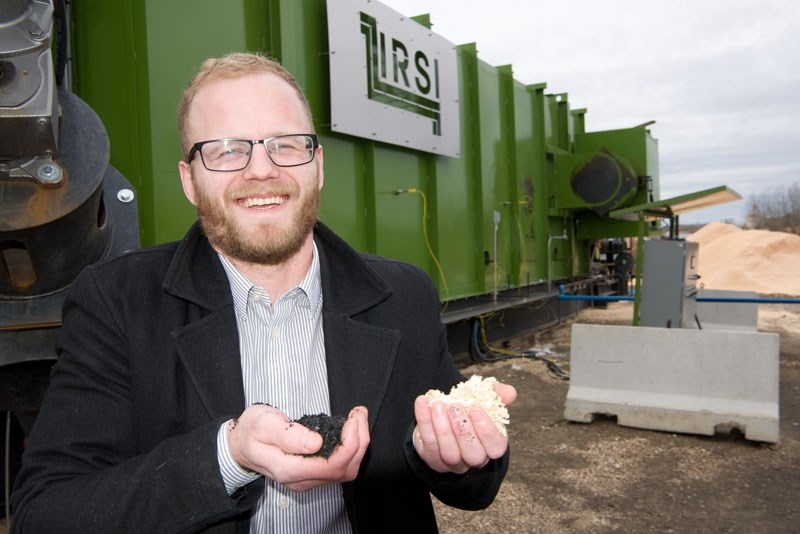It looks like a big green boot, and it could very well help stomp out waste and climate change.
Former St. Albert resident Chris Olson confirmed that his company's $1.6 million experimental pyrolysis machine was now fully operational and making biochar in Drayton Valley with the help of a forestry company.
Olson and business partner Bruce Saunders started work on their big green boot-shaped machine, code-named Ulysses, last year in hopes that it could help companies turn trash into biochar – a hard, black substance similar to charcoal.
Biochar advocates say this substance can permanently trap greenhouse gas emissions in the soil, enhancing fertility and fighting climate change.
Olson and Saunders built the Ulysses device last year but struggled to find a company willing to take the risk of testing it. The pair teamed up with Drayton Valley's Clean Energy Technology Centre to find a partner.
The centre is a business incubator that promotes research and development in the clean energy sector, and has close ties with NorQuest College, said centre spokesperson Manny Deol. Olson and Saunders's device was a perfect fit for Drayton Valley's Weyerhaeuser lumber plant, which was cranking out some 160,000 tonnes of wood waste a year.
"Landfilling is just a waste of a resource," Deol said.
By turning waste wood into biochar, Deol said it becomes something that can be reused in food, cosmetics, fertilizer and many other products, and also displaces fossil fuels that would have been burned to make those products conventionally.
Futuristic Quiznos oven
Olson said the device has been on-site and operational next to the Weyerhaeuser plant for about a month.
The device transforms wood chips from Weyerhaeuser into a fine, almost powdery black char by heating it to about 500 C for about an hour, Olson said.
"The best way to think about it, kind of in layman's terms is kind of like a Quiznos oven," he said, referring to the popular fast-food chain.
A backhoe dumps wood waste into a hopper on one end of the device that's hooked to an airlock, Olson explained. The waste passes through it and drops onto a conveyor belt that pulls it through an oxygen-free hearth.
Propane initially heats the hearth to 500 C. Since there's no oxygen, the wood undergoes pyrolysis instead of combustion, its molecules breaking up and reassembling as pure carbon and by-products instead of CO2. The gaseous by-products get burned outside the hearth to produce the heat needed to keep pyrolysis going without the need for more propane.
The finished char comes out a black pipe on the other end of the device, at which point it can be bagged and shipped. The device can also be fitted with a scrubber to intercept pollutants if it's ever used to burn waste that's not clean wood, Olson said.
The device has successfully produced char and will undergo final tests this month with the help of Alberta Innovates, Olson said. That char could be used in on farms, in filters, and even to produce graphene – a wonder-material whose strength and conductivity give it applications in everything from solar cells to tennis racquets.
The device should reduce greenhouse gas emissions by intercepting waste that would otherwise degrade into methane in the landfill, Olson said. His company projects that the device could sequester up to 12,500 tonnes of carbon a year, equivalent to the emissions trapped by about 691,000 trees over 10 years.
Deol said cities such as Edmonton could use the device to shrink the amount of waste they send to landfills – the device shrinks waste volume by about 70 per cent, Olson said. He hoped projects such as Olson's would spark commercial-scale operations in Drayton Valley and create jobs.
The device should enter commercial production by next summer, Olson said.
Details on the project are available at irsi-inc.com.




